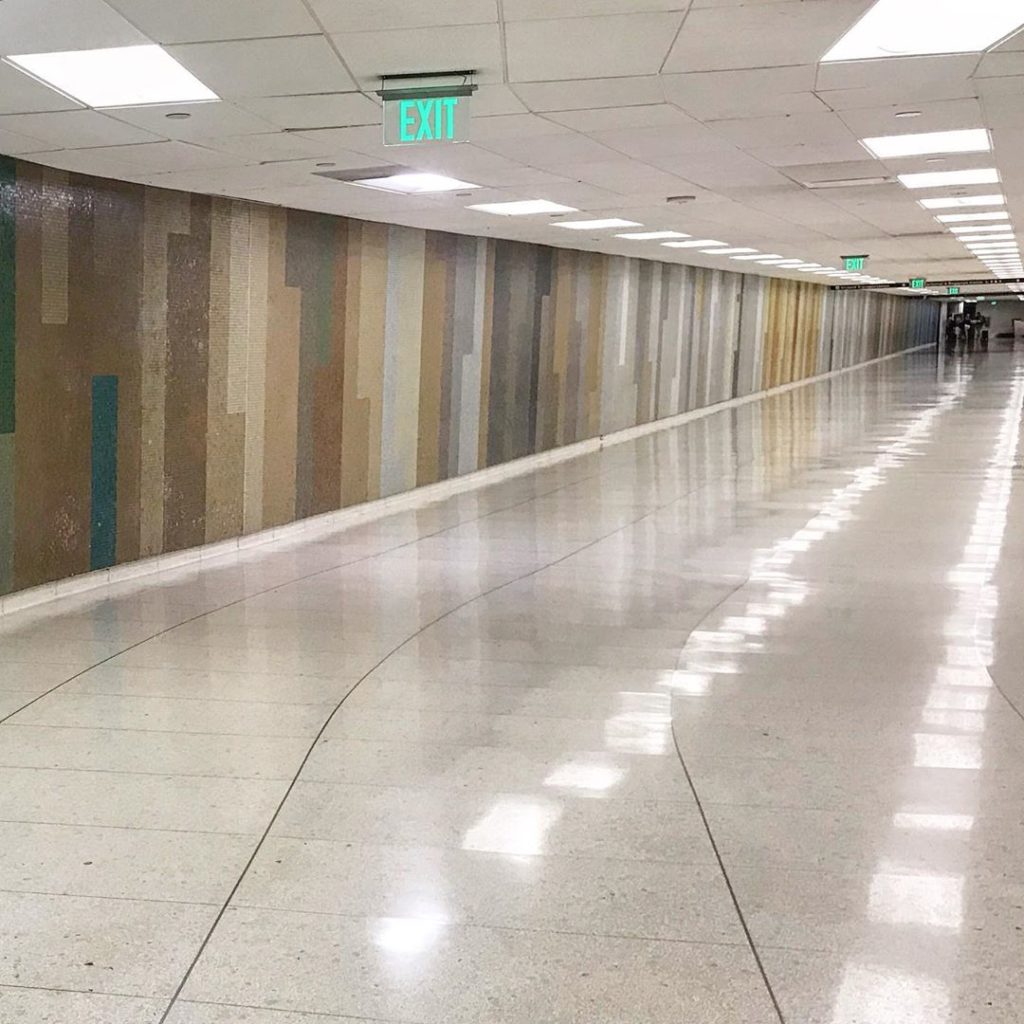Our upcoming exhibition Terminal features art made about the airport, not for it. Artists explore the airport as a form, structure, or idea, through subverting its processes or exploring its histories and politics. We call this ‘terminal art’, rather than ‘art made for the terminal’. The two genres have different responsibilities, remits, and audiences—they serve different agendas. In this blog, we cross the security line between these two types of airport art to highlight a few of the more intriguing examples of ‘art made for terminals’.

Craig Nutt Corncorde 1996, Hartsfield-Jackson Atlanta International Airport
Made in the lead up to Atlanta’s hosting of the Olympic Games in 1996, the commissioning brief was on entertainment value and showcasing the best of Southern American culture. Craig Nutt delivered with this three-metre-long Frankensteinian jet-plane-as-ear-of-corn sculpture caught mid take off. Carved from wood, it has a ‘shuckspan’ of an additional three metres and an A+ title that suggests the artist wasn’t asleep at the cockpit when it comes to the humour and irony of the work. From his Flying Vegetable series—which also includes a carrot airport control tower—Nutt describes the sculpture as a celebration of the region’s primary produce and cuisine. No sniggering, Wellingtonians. Corncorde is a distant relative of the flying Gollum and Gandalf strung up in Wellington Airport to promote local culture and industry. These Weta Workshop props-as-sculptures proudly brand the capital ‘The Middle of Middle-Earth’ and the centre of the country’s film industry.

Duane Hanson Traveller 1986, Orlando International Airport
Duane Hanson’s Traveller has freaked out real travellers since being installed near the Starbucks in Orlando International Airport in 1986 (video evidence here). It must be a surreal experience to get off a plane in a jetlagged state and encounter this hyper-realist sculpture of a dishevelled, impossibly sweaty man forever slumped on his luggage on that endless wait between flights. This would especially have been the case before it was enclosed inside a vitrine. The relocation was deemed necessary as the public could not resist touching him. Apparently, he was repeatedly prodded by other travellers worried that he may have dozed off and missed his flight.
Traveller is the most unlikely every-person. He is so definitively of his own time, place, race, gender, and age, yet somehow still manages to symbolise the state of the traveller and the dead time of airport experience. There is a long Reddit thread dedicated to the sculpture, with a strong ‘believe it or not’ vibe. It includes such gems as ‘The only way I can tell that it’s not a real person is because airports don’t use tags on bags like that anymore. They use that long sticker thing.’ ‘My family and I saw it when we were travelling back from Florida. Scared the living shit out of us.’ ‘I thought it was one of those performance art things.’ And, perhaps most poignantly, ‘He missed his flight thirty years ago.’

Charles D. Kratka and Janet Bennett LAX Murals 1961, Los Angeles International Airport
Abstract modernist murals celebrating the freedom of the jet age dot airports around the globe. While many have been removed as relics, one has taken on an iconic status—mainly thanks to the retro-fuelled workings of pop culture. Mosaic tiled murals were made for LAX’s seven tunnels in 1961, and were designed to capture the new mobility of the jet age. While some of the tunnels were closed as security risks after 9/11, three remain open—including Terminal Six which houses the multicoloured mural known as the Astro Walk. It ‘transports’ passengers from inside to outside the airport—and also symbolically between the West and East Coasts of the US—in the space of a few minutes walk. There is a resemblance to the walk-by murals John Drawbridge made around the same time for and about Aotearoa—for New Zealand House in London and for Expo70 at Osaka.
Film and television have persistently returned to the LAX murals, both as a setting and as a symbol of arrival and transformation. The opening sequences of both The Graduate (1967) and Quentin Tarantino’s Jackie Brown (1997) are set on the Terminal Four travelators. The Astro Walk is used to build ominous tension in Point Blank (1967) and for a chase scene in To Live and Die in LA (1985). Two recent examples tap into the murals’s retro dimension to hark back to the conjoined ‘golden ages’ of film, advertising, and aviation. Tarantino returned to them for Once Upon a Time in Hollywood (2019). Mad Men took the visual cues for—and promoted its entire 2014 final season around—Astro Walk. In the series premiere, Don Draper rides the travelator in front of the mural like so many characters before him. That journey has come to represent far more than the long trip down an empty corridor that a mural was commissioned to enliven in the early 1960s.
—Aaron Lister, Senior Curator
